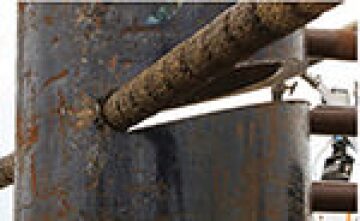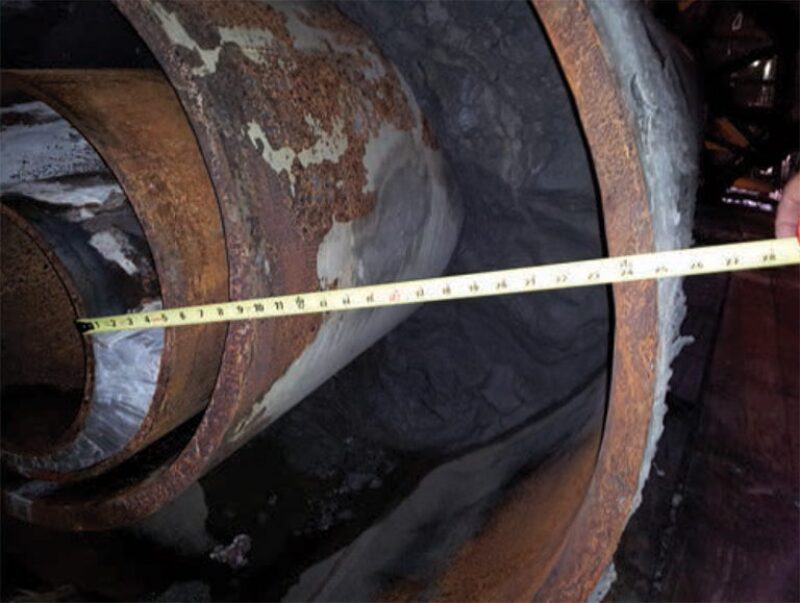In the realm of platform removal, the cutting edge of technology can be taken literally.
Much of the new technology development occurring now is aimed at finding better ways to sever the thick, tough steel structures and wellheads so that they can be removed. There are abrasive cutters that can burrow into the mud, a 2-in. thick abrasive cable like the blade in a giant hacksaw, and even work on sending powerful blasts of laser light through cables that can sever the strongest wellheads.
“With cutting, the promising stuff started up with the understanding that cutting with an oxyacetylene torch by a diver is not very safe,” said Alan Stokes, global decommission manager for WorleyParsons. Manual cutting was followed by cutting using high-pressure streams of grit, abrasive diamond wire looping the pipe, and powerful hydraulic shears.
“The next stage is laser cutting because the trouble with diamond wire and shearing is…the cutting is quick but it takes time to set up,” he said.
One of the biggest supporters of new alternatives has been Chevron, which is looking for ways to reduce the time and risk of cutting, which traditionally has depended on divers and involved cutting torches or explosives. “If there is an alternative to diving we are doing it,” said Don Stelling, president of Chevron Environmental Management. It has adopted a number of cutting methods and is seeking others.
It uses alternatives such as hydraulic shears able to cut 10 in. pipes and a variety of abrasive cutters. Such mechanical severance methods are used for about 35% of all removal operations in the Gulf of Mexico, with explosive methods used in the rest, according to the website for the US Bureau of Safety and Environmental Enforcement (BSEE).

Chevron and Stone Energy avoid using explosives. Regulations enacted to limit the impact of dynamite on marine mammals require surveys of populations near the work site as well as monitors to ensure the work does not injure any protected species.
The decision is “more from a cost than an environmental standpoint,” said Gary Siems, decommissioning manager for Stone Energy. Planning is more complicated when explosives are involved and, if any of the spotters detects a protected species nearby, the work must stop. Also, explosives require moving work vessels out of the blast area, a slow process for the lift boats used by Stone. Traditional alternatives have entailed other risks because divers and explosive gases are required.
The danger was dramatized for Chevron by the death of a diver using a cutting torch in an enclosed area where an accumulation of trapped gas exploded. There is also a limit on how deep divers can work, which is roughly half the depth of the tallest standing structure in the Gulf, and perils such as the risk of cave-ins.
But there are a lot of new options available for the wide range of challenges. There are thick metal components and extremely tough metals to cut, particularly on wellheads, Stelling said.
Areas within the confines of metal structures can be hard to reach, and the surfaces are irregular, often covered with marine growth and anodes, said Brian Twomey, managing director of Reverse Engineering, adding “it is a very complicated piece of work.”
Adding to the difficulty of severing platform legs is the US requirement that it be done at least 15 ft below the mudline. Often the structure is exposed using a high-pressure jet to create a broad, gently sloping, crater-like area around the pipe or column to be cut.
If a diver is involved, there is a risk of a cave-in. Stone has substituted an unmanned auger dredge, a new approach to clearing the space, allowing it to use abrasive cutters, such as an articulated diamond wire saw. Abrasive cutters have been used to address that challenge in a variety of ways. One is internal abrasive cutting, using a torpedo-shaped cutting device inside hollow structural members.
SPE Increases Attention On Managing Aging Fields
The number of aging oil and gas fields has been quietly rising, and SPE is taking notice. Late-life issues have been designated by SPE’s technical directors as a hot topic, a list used to highlight areas of importance in the oil and gas industry where greater attention is required.
Workshops and other events will examine the range of options for wells nearing the end of their lives, ranging from equipment upgrades or enhanced recovery systems, to permanently plugging them and removing the production hardware.
Howard Duhon, SPE director for Projects, Facilities, and Construction, is leading the effort that includes:
- Two events at the 2014 SPE Annual Technical Conference and Exhibition in Amsterdam: a panel discussion on “Aging Assets in the North Sea” and decommissioning was the theme of the annual Projects, Facilities, and Construction dinner.
- A global series of five training courses on decommissioning taught by Brian Twomey, managing director of Reverse Engineering, a consulting firm specializing in this area.
- A workshop in September on the many factors affecting well plugging and abandonment.
- SPE and Decom North Sea, which specializes in data and conferences, are developing workshops on the topic. The co-chairs are Win Thornton, vice president of decommissioning at BP, and Jim Christie, global decommissioning projects manager at Marathon.
The schedule of upcoming SPE decommissioning seminars:
- 11–13 November 2014
Houston, Texas, USA - 9–11 December 2014
Cape Town, South Africa - 11–13 March 2015
Kuala Lumpur, Malaysia - 16–18 March 2015
Rio de Janeiro, Brazil
“The torpedo slides into a pipe once you get it down 15 ft (below the mudline) and an air bladder expands in the pipe,” locking it in the location where it will use a high-powered stream of water and grit to cut through the pipe wall, said Joseph Orgeron, chief technology officer for Montco Offshore, which supplies vessels and crews for offshore decommissioning.
“Doing it from the inside out is by far the most cost-effective way of cutting down there,” he said. But access is often not available so others are working on cutting tools capable of getting down into the mud to make a cut. Orgeron calls it burrowing while Stokes said the machine is “munching down.”
One company is working on a diamond-wire cutter able to burrow into the ground, Orgeron said.
Chevron has tested a device from Versabar that uses a 2-in. abrasive cable that saws back and forth like a cheese slicer cutting down 15 ft into the mud, avoiding the need to clear an area, and then cutting steel or concrete. In its first test, it cut through a thick concrete-filled steel caisson. The time required for the overnight job included a break for observers to go to shore to sleep at night, said Jon Khachaturian, president and chief executive officer of Versabar, which has developed a series of devices.
Next, the plan is to use it to sever four legs on an offshore platform, he said. An automated control system will be used this time that can be adjusted by an operator using a joystick.
Chevron is also looking at possibilities beyond anything in use. It plans to use fiber-optic cables developed by a company called Foro Energy to carry high-powered laser beams capable of rapidly cutting though tough steel.
This would be the first application for the technology startup in Littleton, Colorado, which has filed a patent along with Chevron covering the possibility of using its laser to sever pipe in a blowout preventer.
“We are holding a pilot on that next year. We have been working on laser severing” of undersea structures, Stelling said. “Right now, we are using carbide saws or cutting methods that are not preferred. We are looking at laser severing to speed up the process.”


